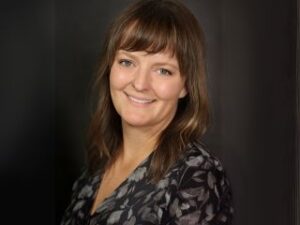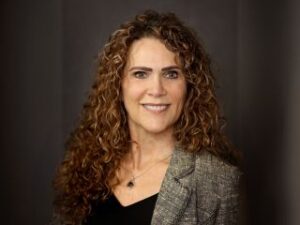 Amy Abel inherited a true love for animals; early on, she knew that caring for them was her calling. She grew up on a farm, helping her mother care for the every day and medical needs of horses, dogs, cats, rabbits, and more. Becoming a registered veterinary technician (RVT) was a natural progression for her, as was the growth into her current role, where she continues to help animals by preparing compassionate, well-trained vet techs to enter the field of veterinary medicine.
Amy Abel inherited a true love for animals; early on, she knew that caring for them was her calling. She grew up on a farm, helping her mother care for the every day and medical needs of horses, dogs, cats, rabbits, and more. Becoming a registered veterinary technician (RVT) was a natural progression for her, as was the growth into her current role, where she continues to help animals by preparing compassionate, well-trained vet techs to enter the field of veterinary medicine.
What is your current title/role?
I am a registered veterinary technician with a bachelor’s degree in technical management. My current title is Program Director for the Veterinary Technology program at Carrington College in Stockton, CA.
What are some of your responsibilities?
My responsibilities include tracking and analyzing data for my program and making sure we meet institutional goals and learning outcomes for the students. I help prepare students to take and pass the Veterinary Technician National Examination (VTNE). *Carrington College prepares students to take appropriate certification and licensure exams related to their individual majors. The College does not guarantee students will successfully pass these exams or be certified or licensed as a result of completing the program.
I also help ensure that the program adheres to the veterinary practices outlined by our programmatic accreditor, the American Veterinary Medical Association (AVMA). *The Veterinary Technology programs at the Pleasant Hill, Sacramento, San Jose, San Leandro and Stockton campuses are accredited by the: American Veterinary Medical Association as a program for educating veterinary technicians.
I also participate in fourth-term surgery lab and other labs/lectures as needed.
How long have you been at Carrington College? And what did you do before this job?
I have been at Carrington College about six years, first as an instructor and now as a program director, a role I’ve been in for fifteen months.
Before I worked at Carrington College, I worked at a Companion Animal Hospital here in Stockton for over eight years. I also worked at the Stockton Animal Shelter for the SFSPCA/APL, where I still occasionally do relief work. I worked for the Emergency Clinic during clinical while in school (and occasionally still do relief work there). I still feel very connected to our veterinary community, even though I am in academia.
How long have you been in the field of Veterinary Technology? How did you know it was what you wanted to do?
I have been in the veterinary tech field for over 15 years. I went to school here on the Stockton campus and graduated in 2009, passing my state boards and becoming an RVT in October of 2009. I like to say I’ve gone full circle! I also like to say we are the voices of those that cannot speak. We have the privilege to be advocates for our patients. We are their voice, if they are in pain or suffering, we can provide pain relief or alleviate suffering.
I knew this was what I wanted to do my entire life. I grew up on 15 acres with all sorts of animals—horses, chickens, rabbits, dogs, cats, rats, and guinea pigs. My grandfather was a veterinarian, and although I did not get to meet him, I think the love for animals runs in my blood. My mom is a medical assistant and I’m sure I got the love for animals from her, too—from a very young age, I helped her give vaccines or deworming, and doctoring up any of our animals that needed it.
What is your favorite part about being Program Director? And what is the most challenging part?
My favorite part of my job is being able to pass on the knowledge of our industry to our students. I like to talk to them about my struggles or my mistakes. I hope that sharing that opens them up to know that it’s okay to make mistakes or have times when completing a task is challenging or has failed. If we don’t fail, we will never have a learning opportunity.
The challenging part is trying to get the students to understand this is a learning environment and that it takes time to become proficient in the essential skills and tasks that they have to get signed off by the end of fourth term. Many students want to get everything right the first time and I understand that but, in this field, it takes practice and repetition to be proficient.
Do you have any words of advice for new students, or those just entering the field?
My words of advice would be that before you get into the Veterinary industry, do your homework. Veterinary technicians have many responsibilities; we wear many hats. It’s a great idea to first volunteer at a local clinic, shelter, or rescue before enrolling in a Veterinary Technology program.
Being a vet tech is not all rainbows and butterflies or puppies and kittens. It can be overwhelming and emotionally challenging but also very rewarding. Many people in our field deal with emotional health, we need to remember that we have to take care of ourselves before we can take care of our patients.
If you compare us to the human medical field, we are anesthetists. We calculate drug and fluid therapy doses and administer and monitor anesthesia patients. We are sterile assistants preparing instruments for surgery, knowing the function and name of these instruments, scrubbing, and gowning in for sterile procedures. We are client communicators and grieving consolers when someone loses a pet. We are dental technicians performing COHATs (comprehensive oral health assessments and treatments) including but not limited to scaling and polishing, extractions, and suturing gingival flaps. We are pharmacy technicians, we must know the medication side effects, mechanism of action, and so forth. We are radiograph technicians, taking diagnostic X-rays, laboratory assistants drawing blood samples and running multi-parameter tests. We are nurses, placing IV catheters, monitoring vital signs, and pain, and keeping the patient comfortable. We are there to do whatever we need to do when our patients need the motivation to want to eat, to get well, and to go home to their families.



